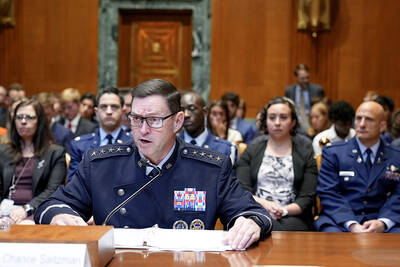IBM reported strong quarterly profits on Wednesday that easily surpassed Wall Street’s estimates, as its reach across global markets and its healthy services and software businesses left it unscathed so far by the weakness of the US economy.
The performance was helped by the decline of the dollar. Most of IBM’s business is outside the US, so a falling dollar lifts reported earnings.
But even in the American market, IBM has proved remarkably successful in sidestepping problems, with sales rising 6 percent in the quarter, an improvement from the last quarter last year, when revenue in the US rose only 2 percent.
IBM, the world’s largest technology services company, reported net profits of US$2.32 billion, an increase of 26 percent from the year-earlier quarter when it earned US$1.84 billion.
Its earnings per share were US$1.65, well ahead of the analysts’ consensus, as compiled by Thomson Financial, of US$1.45.
Revenue for the quarter was US$24.5 billion, an 11 percent increase from a year earlier.
PROFITS
In a conference call, Mark Loughridge, IBM’s chief financial officer, said the company was raising its profit projection for the year.
IBM expects profits of at least US$8.50 a share, up from the previous guidance of US$8.25.
In after-hours trading, IBM’s stock price rose to nearly US$124. In regular trading, before the earnings report, the shares closed at US$120.47, up US$3.30 for the day.
IBM resilience in challenging times, Loughridge said in an interview, has been the result of its strategy, which was fine-tuned early last year. He described it as “two separate views of the global market.”
In advanced economies, including the US, where customers were likely to be tightening their belts, IBM tailored its services and software offerings to help customers cut costs, conserve cash and improve productivity. Those kinds of technology investments, Loughridge said, make sense when the economy is weak.
GROWING MARKETS
In fast-growing markets like China, India and Eastern Europe, Loughridge said, IBM has invested heavily to capture opportunities for new business.
IBM’s strong quarterly results were led by its big services business, where revenue rose to US$14.6 billion, up 17 percent, or 9 percent after adjusting for currency gains. Services represent the majority of IBM’s business, and in recent quarters the growth and profit margins have been improving.
“Fundamentally, the thing that is really rocking for IBM now is the services business,” said AM Sacconaghi, an analyst at Sanford C Bernstein & Co.
The software business grew to US$4.8 billion, up 14 percent, or 6 percent without the currency effects. Computer hardware and microprocessor sales fell to US$4.2 billion, but that business picked up toward the end of the quarter when IBM introduced a new version of its mainframe, the z10.
IBM’s total revenue, after excluding a 7 percent lift from currency gains and 1 percent from an acquisition, grew a modest 3 percent.
“It isn’t that IBM is rocketing ahead of everyone, but it is executing so well in this environment,” Sacconaghi said.

FREEDOM OF NAVIGATION: The UK would continue to reinforce ties with Taiwan ‘in a wide range of areas’ as a part of a ‘strong unofficial relationship,’ a paper said The UK plans to conduct more freedom of navigation operations in the Taiwan Strait and the South China Sea, British Secretary of State for Foreign, Commonwealth and Development Affairs David Lammy told the British House of Commons on Tuesday. British Member of Parliament Desmond Swayne said that the Royal Navy’s HMS Spey had passed through the Taiwan Strait “in pursuit of vital international freedom of navigation in the South China Sea.” Swayne asked Lammy whether he agreed that it was “proper and lawful” to do so, and if the UK would continue to carry out similar operations. Lammy replied “yes” to both questions. The

Two US House of Representatives committees yesterday condemned China’s attempt to orchestrate a crash involving Vice President Hsiao Bi-khim’s (蕭美琴) car when she visited the Czech Republic last year as vice president-elect. Czech local media in March last year reported that a Chinese diplomat had run a red light while following Hsiao’s car from the airport, and Czech intelligence last week told local media that Chinese diplomats and agents had also planned to stage a demonstrative car collision. Hsiao on Saturday shared a Reuters news report on the incident through her account on social media platform X and wrote: “I

SHIFT PRIORITIES: The US should first help Taiwan respond to actions China is already taking, instead of focusing too heavily on deterring a large-scale invasion, an expert said US Air Force leaders on Thursday voiced concerns about the Chinese People’s Liberation Army’s (PLA) missile capabilities and its development of a “kill web,” and said that the US Department of Defense’s budget request for next year prioritizes bolstering defenses in the Indo-Pacific region due to the increasing threat posed by China. US experts said that a full-scale Chinese invasion of Taiwan is risky and unlikely, with Beijing more likely to pursue coercive tactics such as political warfare or blockades to achieve its goals. Senior air force and US Space Force leaders, including US Secretary of the Air Force Troy Meink and

‘BUILDING PARTNERSHIPS’: The US military’s aim is to continue to make any potential Chinese invasion more difficult than it already is, US General Ronald Clark said The likelihood of China invading Taiwan without contest is “very, very small” because the Taiwan Strait is under constant surveillance by multiple countries, a US general has said. General Ronald Clark, commanding officer of US Army Pacific (USARPAC), the US Army’s largest service component command, made the remarks during a dialogue hosted on Friday by Washington-based think tank the Center for Strategic and International Studies. Asked by the event host what the Chinese military has learned from its US counterpart over the years, Clark said that the first lesson is that the skill and will of US service members are “unmatched.” The second